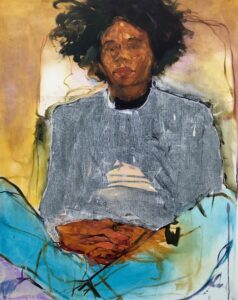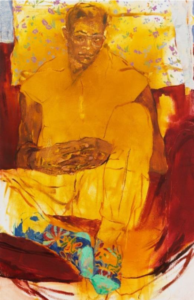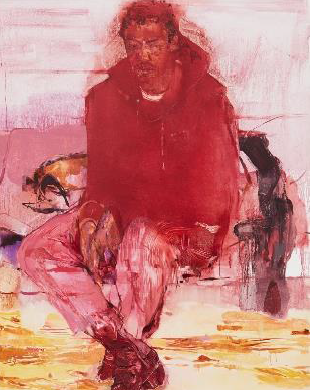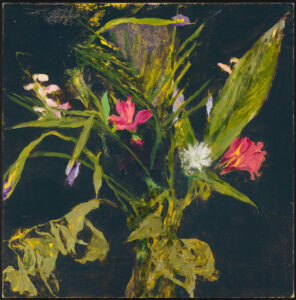
Packer has previously said she has contemplated the devotion and fixation artists put into the process of creating. As such the show’s name is derived from a scripture in the Bible, “All things are full of weariness; a man cannot utter it; the eye is not satisfied with seeing, nor the ear filled with hearing”.
Christabel Johanson writes about the American artist Jennifer Packer.
Jess, 2018. Photo Jason Wyche. Courtesy Sikkema Jenkins & Co, New York
First published: February 6, 2021
Jennifer Packer: The Eye Is Not Satisfied With Seeing
The Eye Is Not Satisfied With Seeing is Packer’s offering into the new year, as well as her first installation in an European establishment. The show includes new paintings created in the last year from her New York studio, as well as rare drawings and past work from the previous decade.
Running from the 5th December 2020-14th March 2021 the national lockdown in Britain has paused the show however the Serpentine Gallery team are working on an exhibition film whilst the gallery is shut.
*
Born in Philadelphia in 1984, Packer now calls New York her base. She graduated from the Tyler School of Art and Architecture as part of the University of Philadelphia. She then went onto attain her MFA from Yale University’s Art School in 2012. From 2012 to 2019 Packer’s work has been featured throughout the United States as well as Sao Paulo.
Packer’s themes revolve around racial politics and representation, “My inclination to paint, especially from life, is a completely political one. We belong here. We deserve to be seen and acknowledged in real time. We deserve to be heard and to be imaged with shameless generosity and accuracy”.

Say Her Name, 2017, oil on canvas
As with the above piece Packer’s intention is wholly political and acts as a tender homage, a “memento mori” and a striking statement. We see a bouquet of smudged mixed leaves and flowers arranged without a vase, somewhat “floating” in stasis. Packer’s floral work is symbolic of the transition from life to death, with a particular eye for composing funeral bouquets. This harks back at Dutch “vanitas” from the sixteenth-century that represent the transitory nature of life and the certainty of death.
Packer’s unique appeal is in part because she refreshes older concepts for the modern world. As a response to tragedies and crises within the Black community, Packer often creates these symbolic offerings. “The bouquets like Say Her Name highlighted something that’s been true in my practice overall, which is this appreciation for observation and also understanding the emotional resonance of the things, the spaces in which we exist and around the people that we care about, whether we know them or not”. Say Her Name was Packer’s response to the death of Sandra Bland who was suspected to have died in police custody in 2015.
*
The emotional resonance and spaces in which we exist is another theme of her work. The artist’s focus on people, whether friends or family members in her portraits, not only provides an intimate insight but also contemporises Black experiences. “Representation and particularly, observation from life, are ways of hearing witness and sharing testimony”. Packer’s work has been described as shifting between foreground and background – this is a play on the spaces of existence – dissolving figures with an abstraction, similar to French post-Impressionist artist Georges-Pierre Seurat.
Her pieces are said to be developed over a period of time which give the final work enough texture to look at again and again.

Tia, 2017, oil on canvas, collection of John Wachs. Photo: Matt Grubb. Courtesy the Artist, Corvi-Mora, London and Sikkema Jenkins & Co, New York.
For instance Tia has the vibrant warmth of yellows centralised in the frame. The subject (who is black) is marked by yellow throughout her clothes, skin and even bleeding onto the background. Surrounded by swirls of reds which turn into browns, the only other colours are on the socks. The colours dissolve through each other and within each other to create a transitory feeling. This is the emotional resonance Packer conjures in her work. There is something nostalgic, something contemplative, something poignant because of this.
The last few years have seen Packer’s star ascend; a solo exhibition in Chicago and work showcased in New York along with awards and other accolades following her. The Eye Is Not Satisfied With Seeing will feature Packer’s monochromatic paintings, floral still lives and drawings all which comment on the themes of politics, race and representation.

Untitled, 2014, charcoal on paper, private collection courtesy the Artist, Corvi-Mora, London
Photo: Jason Wyche
This untitled sketch continues Packer’s ephemeral theme where figures blend into each other and into the background. This is achieved by smudging the charcoal lines that are already traced thinly like whispers on the paper.

The Body Has Memory, 2018, oil on canvas, collection of Miyoung Lee & Neil Simpkins. Photo: Jason Wyche
In The Body Has Memory, reds can be angry or passionate but they are striking and hard to forget. The subject bleeds into the background with a crimson aura. The viewer has always come with the privilege of looking, observing detached from the observed. As a Black artist Packer represents the Black subjects, the Black body in an intimate but challenging way to provoke thought in the viewer. Her figures are dependent on their surroundings because they are a part of their surroundings. The subject’s top – the red hoody – dominates the picture similar to Tia’s socks capturing the eyes. Perhaps fashion in this way anchors the pieces into Black narrative, perhaps they keep the subjects’ uniqueness. Even if we never truly know the answer, we know they signify so much more which changes our viewership for the better.

Untitled, 2016, oil on canvas, private collection courtesy the Artist and Corvi-Mora, London. Photo: Marcus Leith
The viewer may look at her pieces in a reverie at the complexities of the composition, often more than first meets the eye. Fitting then that the show is called The Eye is Not Satisfied With Seeing.
Packer has previously said she has contemplated the devotion and fixation artists put into the process of creating. As such the show’s name is derived from a scripture in the Bible, “All things are full of weariness; a man cannot utter it; the eye is not satisfied with seeing, nor the ear filled with hearing”. The passage hints that there is more than what appears on the surface. Packer’s work goes beyond the exterior, into the depths of layers below and around her subjects. How do we perceive the unperceivable? It is like only getting half of an answer.
Packer cites Michaelangelo or El Greco as some of her inspirational artists, yet their canon of work has been immortalised in time and place across the world. White men who capture the lives of other white men. So when Packer, a Black female, is capturing the lives of Black subjects including other women, she could be part of a new tradition.
*
The artist once said “I realized that I can make a painting of anything – a fantasy, a question, a sadness – and based on the choices I’d make and my attention to what is cared for in the image, I could learn about how I feel and where my genuine concerns lay”. As with the theme of the show, evoking that same level of care and tenderness from the viewing is a multi-sensory experience. It is achieved by more than just looking at the portraits put in front of you. It is achieved by feeling for the subjects, their lives, for feeling towards people who are different from oneself. People who sometimes, like Packer, you may never have met or known. One certainty that the viewers will leave knowing – their stories are more than meets the eye.
